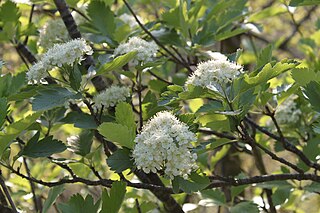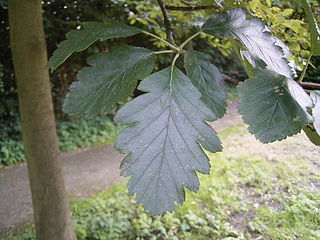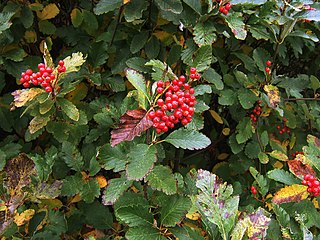
The River Avon is a river in the southwest of England. To distinguish it from a number of other rivers of the same name, it is often called the Bristol Avon. The name 'Avon' is a cognate of the Welsh word afon, meaning 'river'.

Cheddar Gorge is a limestone gorge in the Mendip Hills, near the village of Cheddar, Somerset, England. The gorge is the site of the Cheddar show caves, where Britain's oldest complete human skeleton, Cheddar Man, estimated to be 9,000 years old, was found in 1903. Older remains from the Upper Late Palaeolithic era have been found. The caves, produced by the activity of an underground river, contain stalactites and stalagmites. The gorge is part of a Site of Special Scientific Interest called Cheddar Complex.

Sorbus is a genus of over 100 species of trees and shrubs in the rose family, Rosaceae. Species of Sorbus (s.l.) are commonly known as whitebeam, rowan, mountain-ash and service tree. The exact number of species is disputed depending on the circumscription of the genus, and also due to the number of apomictic microspecies, which some treat as distinct species, but others group in a smaller number of variable species. Recent treatments classify Sorbus in a narrower sense to include only the pinnate leaved species of subgenus Sorbus, raising several of the other subgenera to generic rank.

Leigh Woods is a 2-square-kilometre (0.77 sq mi) area of woodland on the south-west side of the Avon Gorge, close to the Clifton Suspension Bridge, within North Somerset opposite the English city of Bristol and north of the Ashton Court estate, of which it formed a part. Stokeleigh Camp, a hillfort thought to have been occupied from the third century BC to the first century AD and possibly also in the Middle Ages, lies within the reserve on the edge of the Nightingale Valley. On the bank of the Avon, within the reserve, are quarries for limestone and celestine which were worked in the 18th and 19th centuries are now derelict.

Karpatiosorbus latifolia is a species of whitebeam that is endemic to the area around Fontainebleau, south of Paris in France, where it has been known since the early eighteenth century.

Horseshoe Bend, Shirehampton is an 11 acre biological Site of Special Scientific Interest in Bristol, England, on the north bank of a lower, tidal stretch of the River Avon, 1.9 miles downstream from the Avon Gorge, and just east of the village of Shirehampton. It was notified as an SSSI in 1999.

Karpatiosorbus bristoliensis is a species of flowering plant in the family Rosaceae. It is known commonly as the Bristol whitebeam. It is endemic to Great Britain, growing wild only in the Avon Gorge and in the Leigh Woods area of Bristol. There are around 300 individuals as of 2016, and the population is thought to be increasing.

Sorbus leyana. Ley's whitebeam is a species of small tree which is endemic to two sites in southern Wales. It is thought to have arisen by hybridisation of two species of Sorbus, one of which was the rowan. Its closest relatives are some of the other hybrid derived Sorbus species found in Britain.
Aria wilmottiana, commonly known as Willmott's whitebeam, is a species of whitebeam in the family Rosaceae. It is endemic to England, and is found in the Avon Gorge, in Somerset and Gloucestershire. It is threatened by habitat loss.

Scandosorbus intermedia or, formerly, Sorbus intermedia, the Swedish whitebeam, is a species of whitebeam found in southern Sweden, with scattered occurrences in Estonia, Latvia, easternmost Denmark (Bornholm), the far southwest of Finland, and northern Poland.

Hedlundia hybrida, the oakleaf mountain ash, Swedish service-tree or Finnish whitebeam, is a species of whitebeam native to Norway, eastern Sweden, south-western Finland, and locally in Latvia.

Sorbus mougeotii, the Vosges whitebeam or Mougeot's whitebeam, is a species of whitebeam native to the mountains of central and western Europe from the Pyrenees east through the Alps to Austria, and north to the Vosges Mountains.

Sorbus minima, commonly known as the lesser whitebeam or least whitebeam, is a shrub belonging to the subgenus Aria (whitebeams) in the genus Sorbus. It is endemic to Wales where it grows at a few sites in Breconshire. It is an apomictic microspecies which reproduces asexually and so is reproductively isolated from its close relatives such as the Swedish whitebeam, S. intermedia. It probably originated as a hybrid between the rock whitebeam and the rowan. It was first discovered in 1893 by Augustin Ley, the vicar of Sellack in Herefordshire who travelled widely in Wales.

Karpatiosorbus admonitor, previously classified as Sorbus admonitor and also called the no parking whitebeam, is a species of whitebeam tree found in Devon, United Kingdom. It is known only from the Watersmeet Valley at Lynton, with two stray plants growing on the coast above Sillery Sands, Countisbury.

Karpatiosorbus devoniensis is known by the English name of Devon whitebeam and formally as Broad-leaved Whitebeam. When the fruit was reported as sold at Barnstaple Pannier Market the name French Eagles was used, apart from 1929 when they were reported as eagle-berries. When the trees were reported as seen growing wild on botanical walks they were referred to as French Hails. Broad-leaved white-beam, which was the common name until Devon Whitebeam took over, was used once in 1907. The term Otmast was used once as a pet name, as its true identity was not known. It is a species of whitebeam, trees and shrubs in the family Rosaceae. It is endemic to the British Isles, growing wild in areas of Devon, Cornwall, Somerset and south-east Ireland as a native and north-east Ireland as an introduction.
Libby Houston is an English poet and botanist. The native of North London has published several collections of poetry. Houston, a research associate at the School of Biological Sciences at the University of Bristol, has discovered several new species of whitebeam (Sorbus), one of which has been given her name. In addition to membership in several organisations related to botany, Houston is a participant in the Avon Gorge & Downs Wildlife Project. She was the recipient of the H. H. Bloomer medal in 2012. The award from the Linnean Society of London acknowledged her contribution to natural history, in particular, the body of knowledge of whitebeams in Britain, and the flora of Avon Gorge in Bristol, England. In 2018, she was recipient of the Marsh Botany Award, in recognition of lifetime achievement in the field.
Michael Charles Faraday Proctor PhD was an English botanist and plant ecologist, lecturer, scientific author based at the University of Exeter. He retired from his post as Reader in Plant Ecology at Exeter University in 1994.

Torminalis is a genus of plants in the rose family Rosaceae. The genus Torminalis was formerly included within the genus Sorbus, as the section Torminaria, but the simple-leafed species traditionally classified in Sorbus are now considered to form a separate monophyletic group. It is monotypic, being represented by the single species, Torminalis glaberrima, commonly known as wild service tree, chequers, and checker tree. is native to Europe, parts of northern Africa and western Asia.
Aria leighensis, commonly known as Leigh Woods whitebeam, is a rare species of whitebeam, a flowering plant in the|rose family Rosaceae.














